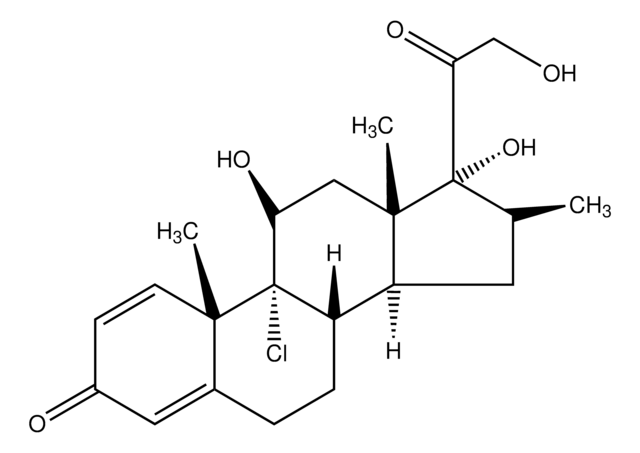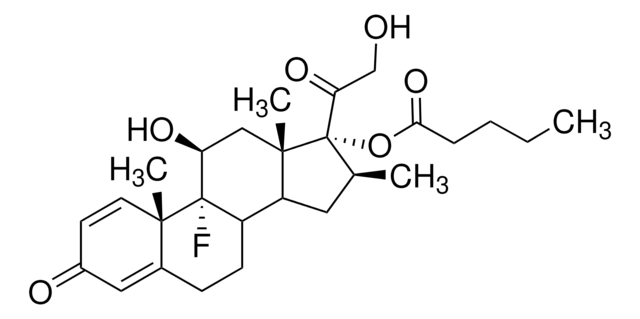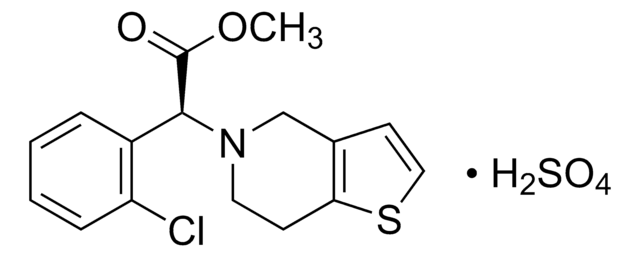B3022
Beclomethasone dipropionate
analytical standard, for drug analysis
Synonym(s):
9-Chloro-11β,17,21-trihydroxy-16β-methylpregna-1,4-diene-3,20-dione 17,21-dipropionate
About This Item
Recommended Products
grade
analytical standard, for drug analysis
Quality Level
Assay
≥99%
technique(s)
HPLC: suitable
gas chromatography (GC): suitable
application(s)
forensics and toxicology
veterinary
format
neat
storage temp.
2-8°C
SMILES string
CCC(=O)OCC(=O)[C@@]1(OC(=O)CC)[C@@H](C)C[C@H]2[C@@H]3CCC4=CC(=O)C=C[C@]4(C)[C@@]3(Cl)[C@@H](O)C[C@]12C
InChI
1S/C28H37ClO7/c1-6-23(33)35-15-22(32)28(36-24(34)7-2)16(3)12-20-19-9-8-17-13-18(30)10-11-25(17,4)27(19,29)21(31)14-26(20,28)5/h10-11,13,16,19-21,31H,6-9,12,14-15H2,1-5H3/t16-,19-,20-,21-,25-,26-,27-,28-/m0/s1
InChI key
KUVIULQEHSCUHY-XYWKZLDCSA-N
Gene Information
human ... NR3C1(2908)
Looking for similar products? Visit Product Comparison Guide
General description
Application
- Development of a reversed-phase high-performance liquid chromatographic (RP-HPLC) method, combined with UV detection to determine beclomethasone dipropionate in nanocapsule suspensions
- Simultaneous determination of beclomethasone dipropionate and ketoconazole in their bulk and combined cream formulations using UV-spectrophotometry and RP-HPLC based methods
- Estimation of beclomethasone dipropionate and formoterol fumarate in their combined dosage forms by stability indicating RP-HPLC method coupled with UV detection
- Combined analysis of beclomethasone dipropionate and formoterol fumarate dihydrate using two UV-spectrometric and one RP-HPLC based methods in bulk and their pharmaceutical dosage forms
- Multi-residue analysis of 21 glucocorticoids in environmental samples by ultra-high performance liquid chromatography (UHPLC) and mass spectrometry (MS)
Other Notes
Signal Word
Warning
Hazard Statements
Precautionary Statements
Hazard Classifications
Repr. 2 - STOT RE 2
Target Organs
Adrenal gland,Immune system,Bone
Storage Class Code
11 - Combustible Solids
WGK
WGK 3
Flash Point(F)
Not applicable
Flash Point(C)
Not applicable
Personal Protective Equipment
Choose from one of the most recent versions:
Certificates of Analysis (COA)
Don't see the Right Version?
If you require a particular version, you can look up a specific certificate by the Lot or Batch number.
Already Own This Product?
Find documentation for the products that you have recently purchased in the Document Library.
Customers Also Viewed
Our team of scientists has experience in all areas of research including Life Science, Material Science, Chemical Synthesis, Chromatography, Analytical and many others.
Contact Technical Service










